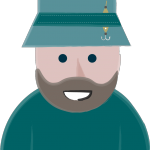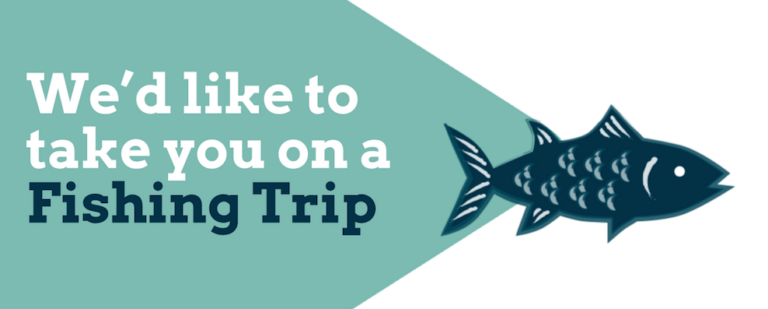Here’s a story about a fishing trip, and along the way, about some of the main objects in Salesforce, in a sales and marketing implementation. Before we begin, it’s worth just letting you know that everything we are about to tell you about Salesforce is entirely true….but we are no experts when it comes to fishing.

There are things swimming around in the loch, Alex is sure about that. He can see the odd movement under the water, ripples here and there, bubbles rising to the surface. The fact is though, that he doesn’t really know what he’s dealing with, just that’s there is something in there.
In Salesforce terms, we can call these unidentified, below-the-surface ripples, LEADS. That’s to say, you might have an email address for this person, perhaps a twitter ID, but you don’t know too much more e.g. company name, job title etc. You might even have bought a list of potential customers, and imported it into your CRM, and now need to work out if they are actually bona fide contacts. That’s when you use the leads object.
Meanwhile, back at the loch, Alex has been sitting there for a while and he has seen a few frogs hopping around in the shallows, the odd newt, but importantly he has also seen what he came for….fish. He got some more information to work on now, and as a rather accomplished fisherman, he can identify if it’s carp, salmon or trout.

Of course, the thing about fish is that they often swim together in a shoal. Different fish, same family – just like a number of individuals can belong to one organisation. That’s when the ACCOUNTS object comes into play. Multiple contacts from the same organisation, can all belong to the same account. In this way you can clearly see who works where, and with whom.
So the scene is set, and it’s time for some action. Our hero Alex is sitting by the side of the lake, rod laden with the juiciest of worms. That’s when he feels a tug on this line. This is an OPPORTUNITY. That’s to say, one of his contacts has shown interest in what he is offering.
It’s a big moment for any fisherman, and Alex has been here before a time or two. He knows that landing a fish is a tricky process, involving a number of stages. He shouts to his fishing trip companion ‘We’ve got a NEW PROSPECT here!”, and his companion springs into life and rushes over with his landing net, otherwise known as a QUOTE.
Of course every business has a unique process for safely ‘landing’ their opportunities. For example, you might need to send out a contract. Possibly you need to trigger a due diligence process before you can take the opportunity further. The good news is that Salesforce can be configured in any way you want, to land your fish.
What is fairly universal however, is the fact that there are almost certainly two outcomes at this point.
Either it’s CLOSED WON ..and that means it’s fish for dinner.

got away.
Before Alex sets off to the loch (or on his CAMPAIGN), he had made sure beforehand that he was carefully prepared to catch as many fish as possible. Alex is a keen fisherman, and he doesn’t just go on one trip a year. In fact Alex takes quite a few trips, and what’s more he plans them very carefully.
This season he is going to fish for trout in Loch Tay, Loch Ness, Loch Leven, but not just that, he’ll also be fishing for salmon in Loch Ken, Castle Loch and Loch Drunkie. He’s got this plan for the 2016 season pinned up on his noticeboard at home – it’s his CAMPAIGN HIERARCHY.
Back once again to Salesforce: organising your campaigns using the Salesforce hierarchy is the perfect way of keeping track of your strategy and tactics in one view. ‘2016 Season’ sits at the ‘grandparent’ level, (in our instance of Salesforce this represents ‘Marketing 2016’). Below this, you have your ‘parent’ category as a sub-category of your marketing plan e.g. Content, Events, PR, Social Media etc. Below this again, as a child campaign, you can organise and record details of each of your marketing efforts e.g. ‘New prospects information event May 2016’.
The great benefit of using the campaign hierarchy is that you now have a lot of options on how you can organise, slice and dice your data on your campaigns at various different levels. So if you want to know how many opportunities came through sitting beside Loch Tay last year, then you can, but if you want to know whether salmon fishing or trout fishing brings more opportunities overall, then you can do that too with a logically organised campaign hierarchy.

So, he’s got his trip planned, he has worked out what it’s going to cost him. However, there are still a few details to think through before he hits the road to the highlands. It’s this kind of upfront thinking that Alex knows will make or break his trip: and just like there is no point arriving at a campsite and realising you’ve left the firelighters at home (or worse still the beers), 
So, let’s say for example you are a fishing tackle supplier. Your plan is to send out a campaign later that year, to all those leads who indicated that they were interested in hearing about new specialist salmon flies. Well, in that case, you had better make sure you have a field set up to capture the fact that they want news on salmon flies. Simple with foresight… trickier in hindsight.
Ok, now at the risk of turning this into Moby Dick, we still have more story to tell. Back at the loch, Alex has discovered something about the fish he is trying to catch: he seen them before. In fact, more often than not, these fish like to have a few little looks at the bait before they are willing to have a nibble. Each time, the fish get a little bit closer, a little bit closer still, and finally.. that’s when Alex hooks them.
So it wasn’t just one fishing trip that hooked the fish, it was the culmination of several trips that brought the fish closer, closer, and closer still until finally they were a fish dinner. And that’s where CAMPAIGN INFLUENCE comes in. You will have seen it for yourself no doubt: sometimes you need to contact the same person via a number of marketing campaigns, before they decide the time is right for them to take action. It’s not just that final touch point that made them buy (or commit /sign up etc) but the combination of all the times you’ve been in contact with them, in the past.

Alex’s 2016 fishing season was long, happy and successful. Back at home, his family were keen to hear of his progress and never tired of the details. Alex sent a postcard everyday, filling them in on exactly how many nibbles he had, how many fish he had landed, the kind of bait he had used etc.
The great thing about Saleforce is that you can give the important people in your life an instant snapshot of where you are, with DASHBOARDS and REPORTS. Salesforce has a number of standard versions pre-set up, but if you need something tailored specifically to your organisation, then the good news is that they can be configured to deliver information on anyone aspect of your data.
So there you are, a Salesforce fishing saga (possibly the only known example of this literary genre). It’s a simple tale to hopefully give you a little insight into a vastly complex product. Sometimes though, the simple stories are the best (we have always believed in more thinking, less technology). If you want to talk more about how Salesforce can help your organisations achieve it’s goals, then get in touch with Shaun Holmes.
If you want any advice about fishing however, you may want to go elsewhere…

Our independent tech team has been servicing enterprise clients for over 15 years from our HQ in Bristol, UK. Let’s see how we can work together and get the most out of your Salesforce implementation.